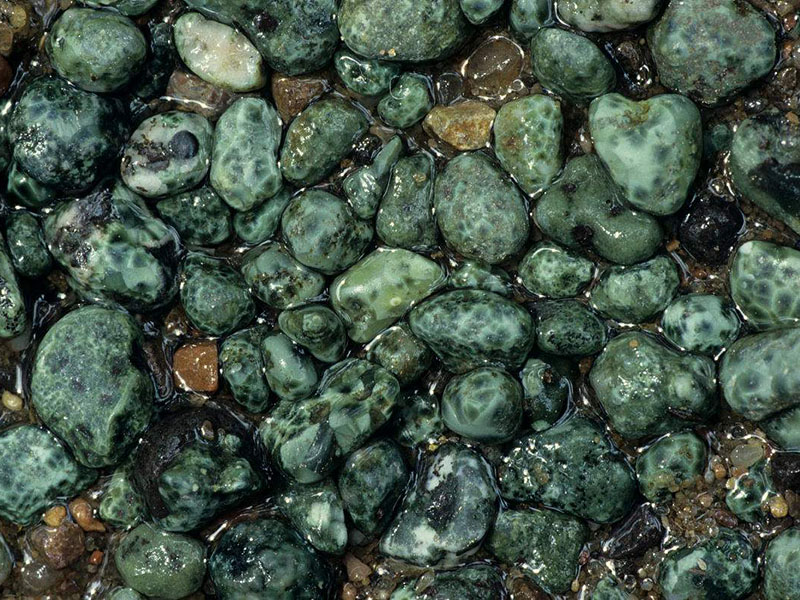Pumpellyite is named after R. Pumpelly, who first studied and described the Pumpellyite on the Kewero, Peninsula in the United States.
The Chinese name “绿纤石” comes from its green and fibrous appearance.
- Composition: Ca4MgAl5SiO4 [Si2O7] 2 (OH) 5 ・ H2O. The content of AI is significantly higher than that of Mg and Fe, with more H2O.
- Form: It belongs to the monoclinic system. The crystals are plate-like, needle-like, and fibrous; the aggregates are spherical, rose, and radial.
- Photometric property: It is colorless or green, yellow or brown in thin slices. Colored one are polychromatic: Np=colorless, light yellow, light yellow-green, pale yellow-brown, Nm=light brown yellow, light green, blue-green, and Ng=colorless, light yellow, yellow, light brown yellow. The absorption is Np<Ng<Nm. Np=1.665~1.702,Nm=1.670~1.709,Ng=1.683~1.722,Ng-Np=0.018~0.020。 (+) 2V=10 °~ 85 ° (mostly 40 °±), Nm/b, Np λ a=11 °~ 39 °, Ng) c=4 °~ 32 °.
- Occurrence: Pumpellyite occurs in low-grade regional metamorphic rocks and is often the altered product of plagioclase.

What is the difference between Pumpellyite and epidote?
There are many similarities between Pumpellyite and epidote, and their differences are:
- Pumpellyite is characteristic green and green-blue in the Nm direction.
- The interference color is low, mostly I grade orange-red.
- Due to strong dispersion, it is difficult to achieve complete extinction under the orthogonal mirror.
- It is a two-axis (+).
What is the difference between Pumpellyite and Chlorastrolite?
Pumpellyite is a variety of epidote, and the chemical formula is Ca4MgAl5SiO4 [Si2O7] 2 (OH) 5 ・ H2O. The aluminum content is high, exceeding that of magnesium and iron (Fe2+and Fe+), and is close to plagioclase.
According to the different types of iron ions contained, It can be divided into:
- Ferrophyllite: magnesium in the composition is wholly replaced by ferrous ion (Fe2+); The chemical formula is Ca2Fe2+Al2 (SiO4) (Si2O7) (OH) 2 ・ H2O. There is no independent Ferrophyllite crystal in nature, which is always mixed with Pumpellyite and Julgoldite.
- Julgoldite: It has Fe2+replacing Mg2+and Fe3+replacing part of Al+. The chemical formula is Ca2Fe2+(Fe3+, Al)2(SiO4)(Si2O7)(OH)2·H2O. It generally coexists with Pumpellyite and Ferrochlorite.
Physical properties of Pumpellyite
It belongs to the monoclinic system, with space group A2/m. ao=8.83,bo=5.90,co=19.17A; β= 97°07’。 Z=2. Spectral lines of main powder crystals: 2.90 (100), 3.79 (50), 2.74 (50).
The monocrystals are in the form of plates and needles extending along the b-axis, and the aggregates are in the form of fibers, spheres, roses, radiations, dense blocks, etc.
The color is bright green, dark green, blue-green, dark green, brown, or colorless. It has Glass luster to silk luster, translucent to transparent.
It has a cat’s eye effect after being processed into cambered gems.
Tips:
What is the Pumpellyite cat’s eye?
A fibrous aggregate of Pumpellyite can be ground into cabochon gemstones with a cat’s eye effect. But the light band is often wide, and the effect is not good.
Cleavage {001} is medium. The hardness is 5.5~6.5, and the density is 3.18~3.33g/cm3.
It is Colorless or light green, Light brown, or light yellow under transmitted light.
Clear pleochroism:
- Ng is colorless, yellow, light yellow, light brown yellow,
- Nm is light green, green, dark blue-green, blue-green, light brown-yellow,
- Np is colorless, yellow, light brown yellow, light green yellow.
It is a Biaxial crystal, positive gloss, 2V10 °~85 °, generally 40 °.
Refractive index: Ng1.683 ~ 1.722, Nm1.670 ~ 1.709, Np1.665 ~ 1.702.
Birefringence : 0.018 ~ 0.020.
In terms of arts and crafts, The crystal is required to be bright, transparent, and large in size; It is generally required that the aggregate is bright green, dark green, or emerald green, dense, tough, and large in size.
According to the difference in aggregate structure and appearance characteristics, the Pumpellyite can be divided into:
Fibrous Pumpellyite: It has a cat’s eye or cat’s eye flash after being processed into curved gemstones;
Massive Pumpellyite: It is bright green, dark green, or emerald green, is similar to the “emerald green” in jadeite varieties, and is extremely precious, so it is called “Imperial jade.”
Where does the Pumpellyite come from?
Pumpellyite is mainly produced in low-grade regional metamorphic rocks, especially Glaucophane Schist, greenschist, skarn, hornfels, greenstone, albite porphyry, dolerite, which is the product of low-grade metamorphism and hydrothermal alteration and is often formed by alteration of biotite.
In greenschists, Pumpellyite often coexisted with epidote, anhydrite, chlorite, actinolite, albite, etc.
The countries in the world that produce gem grade Pumpellyite include the United States, Britain, Austria, Finland, the former Soviet Union, New Zealand, South Africa, etc.
China has found Pumpellyite in Hanzhong, Shaanxi Province. Its symbiotic minerals are plagioclase and a small amount of muscovite, apatite, rutile, magnetite, etc., but the value of its gemstone remains to be studied.
Chlorastrolite
Chlorastrolite is a planetary variety of Pumpellyite. Its material composition, internal structure, and basic characteristics are the same as those of Pumpellyite, except that its hardness is 5~6, and its density is 3.1~3.5 g/cm. It is produced in the basic igneous rock of Lake Superior, the blue-green schist of California, and the basalt of New Jersey.
Conclusion:
Pumpellyite is a hydrous calcium-magnesium-aluminosilicate mineral.
It is a monoclinic crystal system, mainly in the form of fibrous or dense massive aggregates; The color is Bright green, dark green, light blue-green, and brown.
Pumpellyite occurs in the pores of alkaline or basic igneous rocks. The famous origin is the Royal Island of Lake Superior in the United States.
It is produced in the form of pebbles and has a unique white-green texture due to the inclusion of other substances. The emerald green one looks like jadeite, but its hardness is low. It is also found in Russia, South Africa, Finland, and other places.
